Nick Walker, Stephen Wenger, and the gang at the Snub Gun Study Group (SG2) asked an interesting question recently:
What is a “Snub?”
Drawing lines
Consider the following guns, for example, and ask, “are these snubs?”
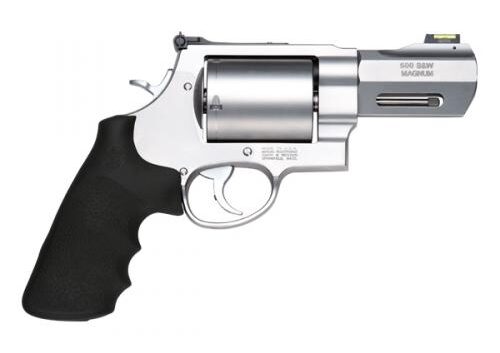
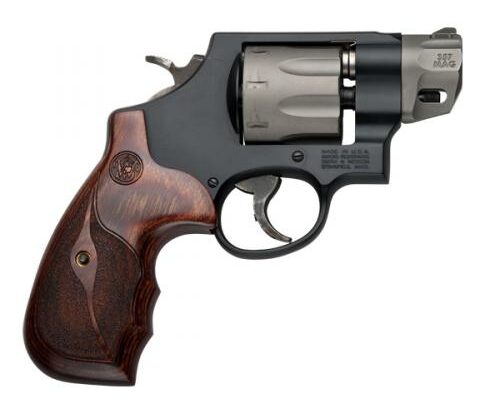
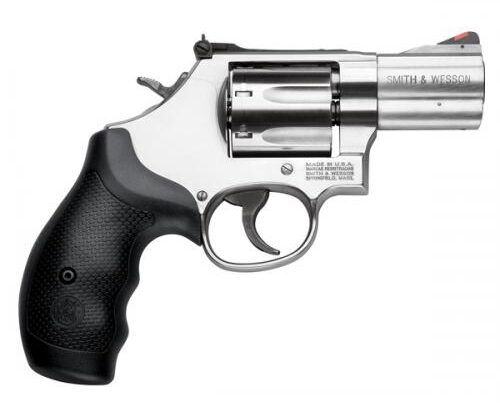
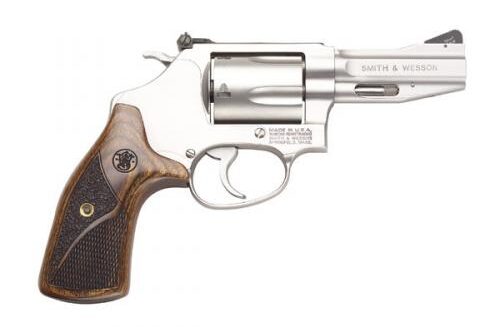
I think it’s fair to say that we’d get a pretty good mix of opinions from a survey like that. Some may object to the large frame guns, even though they have shorter barrels than normal, while others may object to the longer-than-normal barrel on the tiny J-Frame.
I think this is too narrow a view, however. While the tendency is to focus exclusively on barrel length, I think frame size, intended carry mode, and the balance between various weapon selection priorities must be part of the equation.
One could argue, for example, that the Ruger Super Redhawk Alaskan, which has a barrel that’s effectively cut off flush, at the end of the burly frame, is a “snub” by virtue of its short tube. However, I personally don’t think “snub” when I see a massive, 44 ounce gun that’s chambered in velociraptor calibers (h/t Michael Bane) like .454 Casull and .480 Ruger! Yes, it’s shorter than usual, but I don’t think of it as a “snub.”
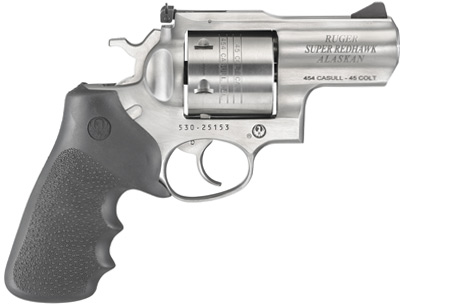
I feel the same way about the large N-Frames, or even the L-Frames with short barrels. It gets a little harder to parse things when we get to the shortened K-Frames, but even those don’t strike me as “snubs,” per se.
defining the Snub
I’ll freely admit that many knowledgeable people would disagree with my interpretation of things, but if you asked me to break down the elements that make a “snub,” it would look like this:
Snub
-
-
- Short barrel, under three inches;
- Compact frame, roughly S&W J-Frame, Colt D-Frame, or Ruger SP-Frame in size;
- Particularly well-suited or optimized for pocket, ankle, or other non-belt-mounted carry modes;
- The balance between shooting/handling qualities, ballistic performance, and concealment favors concealment as the priority.
-
It’s important to note that #3 doesn’t preclude its use as a belt gun, but helps to define the “spirit of the law.” You can carry a snub on a belt if you want, but to me, the magic of a snubby is that a belt is not required to carry it effectively. Got a pocket? Cool, you’re good to go.
The last factor, #4, is the key to the whole snub concept for me. It’s true that every gun is a compromise of some sort, which requires us to prioritize our needs and make exclusive choices in our quest to find the best tool for the job. We’d all love to have a gun that shoots like a .22, hits like a 12 Gauge, handles like a full size, yet carries like a NAA Mini, but since these qualities are at odds with each other, we have to give and take a little, to reach a reasonable compromise.
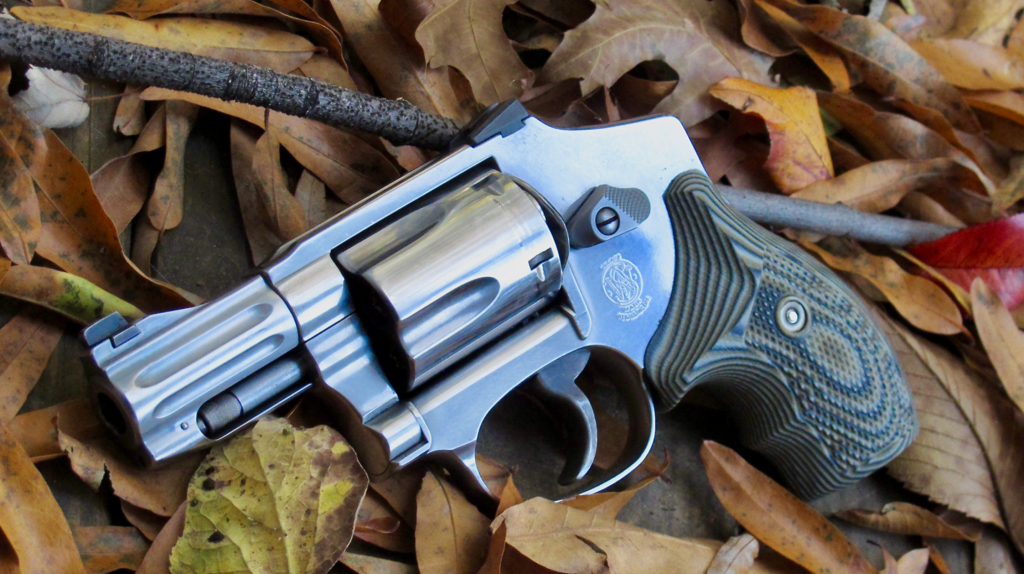
With the snub, I think that compromise is heavily weighted towards concealability, at every turn. We choose a frame size that allows us enough purchase and control to be practical, but not one that’s big or heavy enough to compromise concealment. We choose a caliber that’s powerful enough to do a reasonable job of stopping an attacker, but is still controllable enough in the smaller and lighter gun that we intend to hide from view. We accept a reduced round count, in order to keep the overall package compact.
If we were more concerned about power, handling qualities, shooting characteristics, or capacity, we’d choose a larger and more capable gun, wouldn’t we?
not a snub–the service gun
So, if those qualities define the snub, then how would I classify the other guns that are not snubs?
To answer that, I offer the following classes for consideration, starting with the Service Gun.
Service Gun
-
-
- Medium to Large frame;
- Barrel length of three to six inches;
- Minimum caliber of .38 Special;
- Intended and/or particularly well-suited to be carried in a belt-mounted holster;
- The balance between shooting/handling qualities, ballistic performance, and concealment overwhelmingly favors the first two, as the priorities.
-
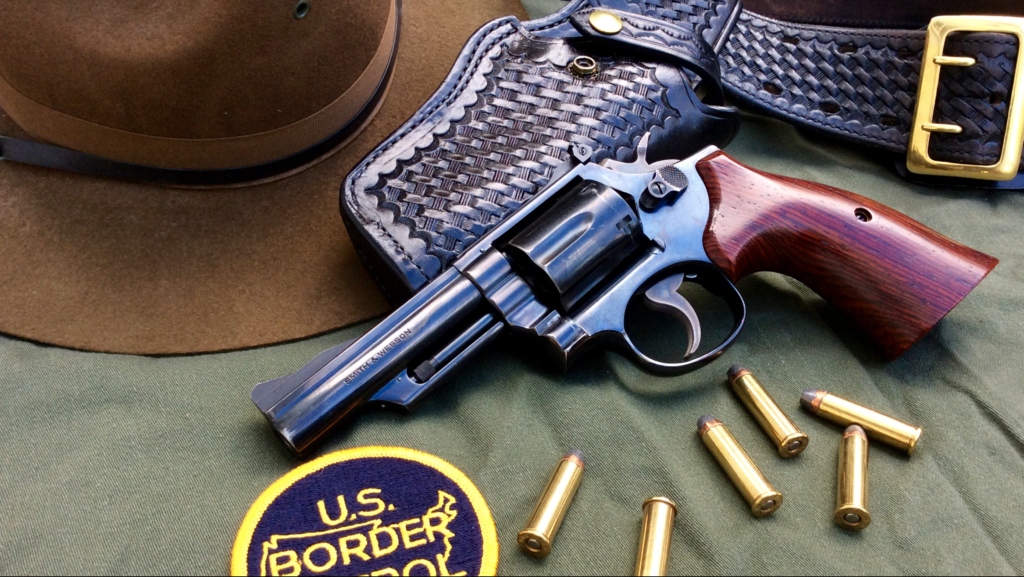
The guns in this category would include the typical military and police revolvers of the 20th Century, which ruled the roost prior to the widespread adoption of autos. These are the full-size duty revolvers that are intended to be carried openly, and are picked primarily for their reliability, handling qualities, and suitable power.
Concealment is not considered to be an important factor in the selection of these guns, and is typically ignored entirely. Instead, the focus is simply on providing the best fighting gun that can be openly-carried within reasonable size and weight constraints.
Not a snub–the compact service gun
Which leads us to the next category, the Compact Service Gun:
Compact Service Gun
-
-
- Medium to Large frame;
- Barrel length of three or less inches;
- Minimum caliber of .38 Special;
- Particularly well-suited to be carried in a belt-mounted holster, but capable of being carried in some larger pockets, or on the ankle, by virtue of its shorter length, modified grip frame, or reduced weight;
- The balance between shooting/handling qualities, ballistic performance, and concealment favors the first two, as the priorities.
-
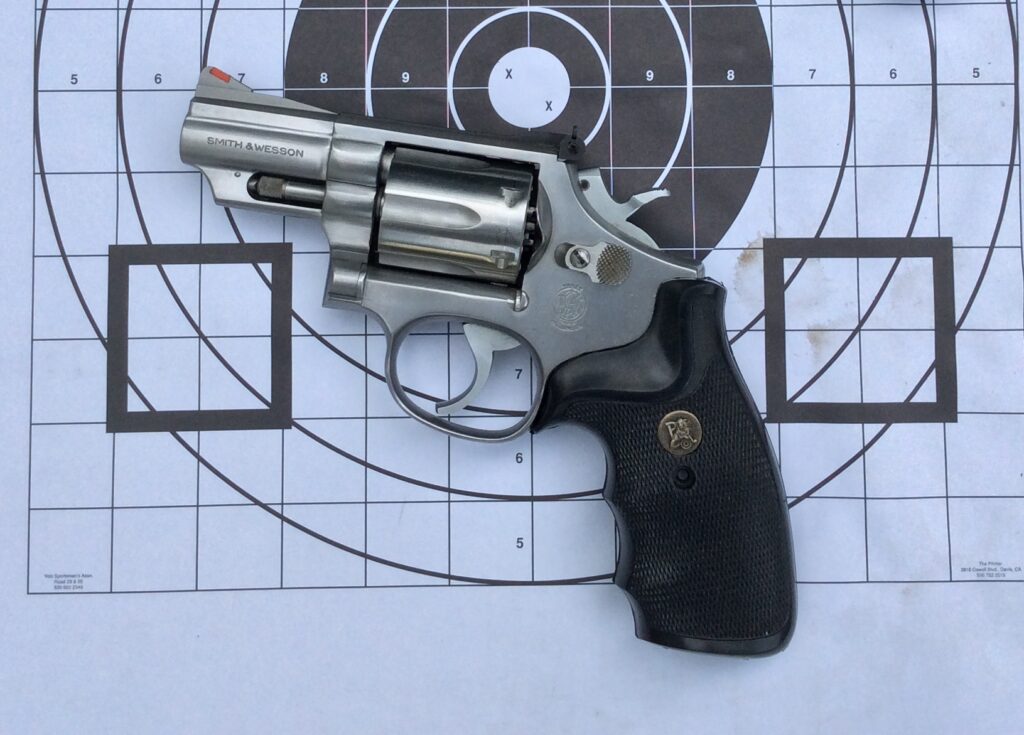
In this system, the primary physical characteristic that distinguishes the Compact Service Gun from the Service Gun it’s derived from, is the shortened barrel, but the Compact Service Gun may also have a shortened or reconfigured grip frame, as well (i.e., a round butt, in lieu of a square butt).
In any case, what really makes the Compact Service Gun different from its larger parent, in my opinion, is the increased emphasis on concealment. While concealment still doesn’t rise to the level where it’s prioritized above shooting/handling qualities and ballistic performance, it receives considerably more attention in this evaluation, than it does in the case of the Service Gun. Essentially, the user of a Compact Service Gun wants to retain the functional qualities of the Service Gun in a package that is smaller, lighter, and easier to conceal.
It’s true that some users may simply be chasing size and weight reductions as their primary consideration, with enhanced concealment being just a related benefit, but I think enhanced concealment should be viewed as the driving factor. Lopping off some barrel will certainly reduce size and weight, but the weight savings pale in significance to the gains in concealment and handling qualities that are achieved with the shorter barrel. The magic of a 2.5″ Combat Magnum, for example, is not the loss of a few ounces, but how it carries, where it can hide, and the way it clears leather compared to the four-inch Service Gun.
Not a snub–the outdoorsman’s gun
We might also add a fourth category, to cover all the big guns with short barrels that are used for hunting, or defense from four-legged predators:
Outdoorsman’s Gun
-
-
- Medium-Large to Extra-Large frame;
- Barrel length under four inches, but typically less than three;
- Minimum caliber of .357 Magnum, though frequently much larger;
- Sometimes equipped with muzzle brakes or barrel ports;
- Intended and/or particularly well-suited to be carried in a belt or chest-mounted holster, or in some kind of off-body holster, like a pack, case, or saddlebag;
- Intended primarily for use against game or animal predators, not bipeds;
- The balance between shooting/handling qualities, ballistic performance, and concealment favors ballistic performance.
-
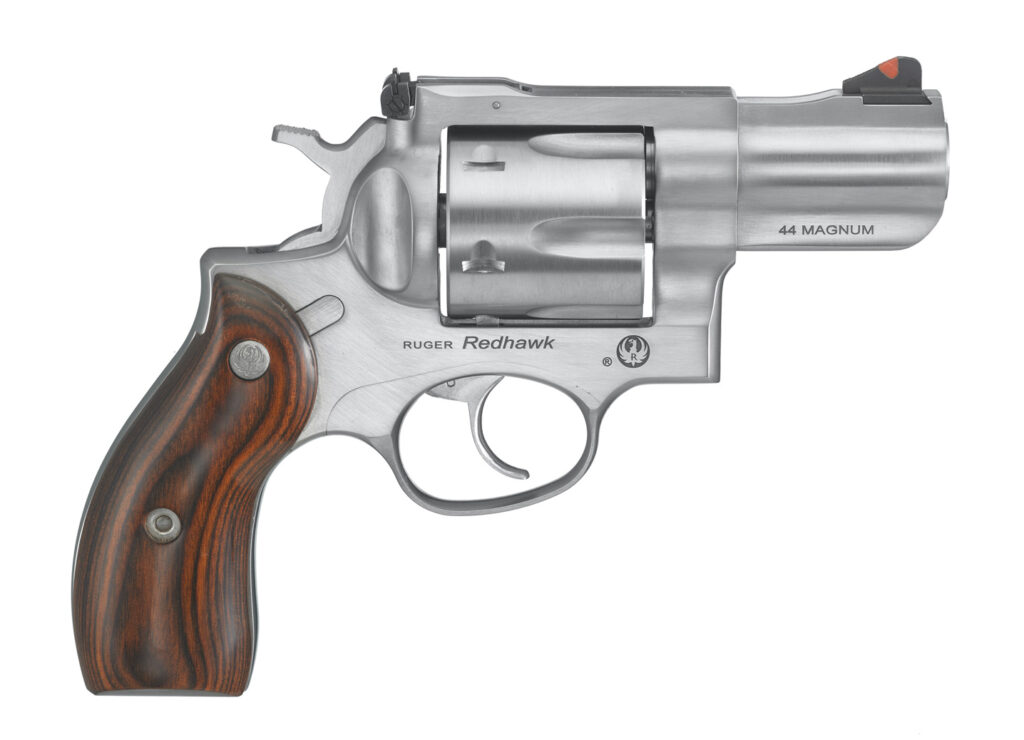
In contrast to the other categories, where the anticipated threat is a human, the short-barreled Outdoorsman’s Gun is intended for use against animals. The Outdoorsman’s Gun can be used for hunting, but is more often used for defense against aggressive animals in the wild.
There may be a bit of crossover with the Service Gun, here, in that some of the larger Service Guns could be successfully used for animal defense, with proper ammunition selection. However, the intent of this category is to capture guns that are oriented towards animal defense, including the guns that are chambered for big bore cartridges that would generally be considered excessive for personal defense against humans.
The guns in this category tend to favor those heavy-hitting cartridges, which are chosen for their ability to penetrate animals with tough skin, thick, hard bones, lots of muscle or fat, and deeply-seated organs. The short barrels on these guns are primarily selected for weight savings and portability, not for concealment.
but what about?
Admittedly, there are some examples which challenge the rules and don’t fit neatly into the categories I described above. The North American Arms mini revolvers, for example, hardly qualify as a “snub” in my view, and they certainly don’t fit into the other categories. Perhaps a “novelty” class would be an appropriate addition, here?
Additionally, there are some guns that knowledgeable RevolverGuys might reasonably disagree about, when it came time to classify them. Some of these “wobblers” might include:
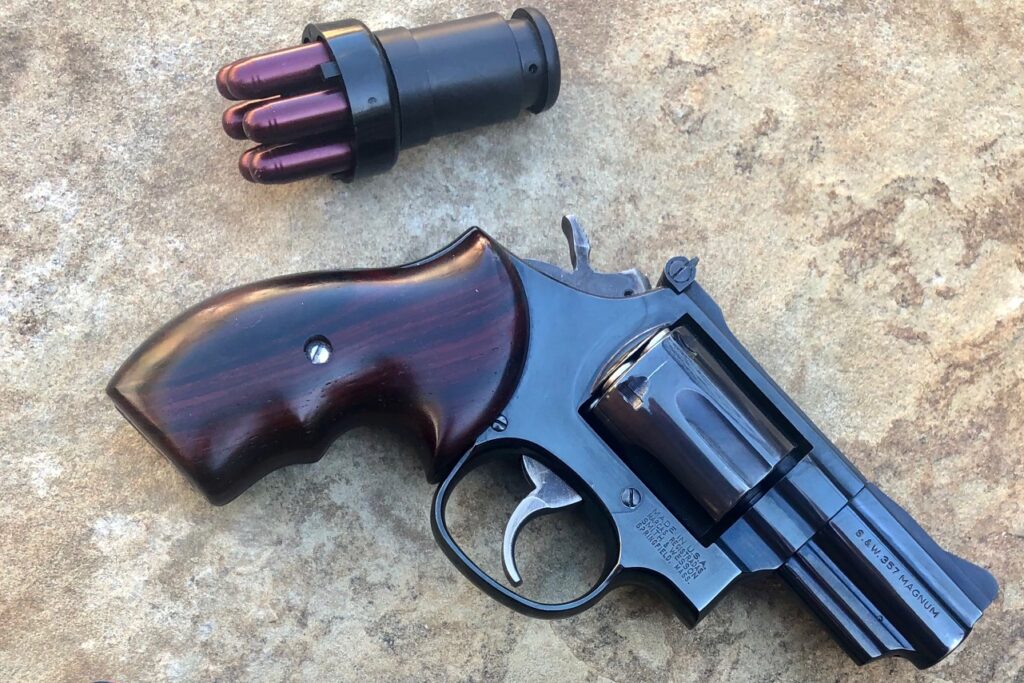
The shortened K-Frames. You could arguably include the shortest versions of these as “snubs,” but under my admittedly-subjective rules, I classify them as Compact Service Guns. While a shortened K-Frame could be carried in some pockets, or on the ankle, it’s not as well-suited to the task as its J-Frame counterpart, and is often more effectively carried on the belt, instead. More importantly, while the shortened K-Frame is more easily concealed than the Service Gun it’s derived from, the person who carries a shortened K-Frame is more concerned about preserving the superior shooting/handling qualities and ballistic performance of the larger Service Gun, than they are about maximizing concealment. If concealment were their first priority, then they would choose a smaller gun, that more neatly fits the “Snub” category, instead.
The longer, but still shortened, three-inch K-Frames are a bit of a wobbler too, straddling that border between Service Guns and Compact Service Guns. A three-inch K would make a dandy Service Gun, and I’d generally lump the square-butt versions (like the Model 10s issued in Australia, Canada, France, and Turkey, for example) into that category, but the round-butt models (like the FBI’s Model 13s) probably belong in the Compact Service Gun category, since the frame change was made to enhance concealability. Yes, it’s subjective, but it’s my football, so I make the rules! ; ^ )
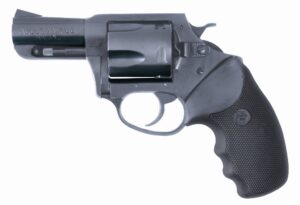
The Charter Bulldog. Similar to the shortened K-Frames, under this system, I’d class the 2.5 inch Bulldog as a Compact Service Gun. Historically, “Bull Dogs” were created from chopping down Service Guns, like the Webley or Colt New Service revolvers. I think this pattern was reversed at Charter Arms, where the shorter, two and three-inch versions preceded the longer four-inch version (today’s Target Bulldog model is 4.2 inches), but the general relationship holds true. One could argue the Charter Bulldog was designed from the ground up to be a Snub, and should fall in that category, but I disqualify it in my system because the desire for enhanced ballistic performance is a priority over concealment. If concealment were prioritized, the user would select a smaller and lighter frame that handled a less powerful cartridge, and was more easily concealed.
How about you?
So, that’s how I slice things. It’s an admittedly subjective system, but it works nicely for me. You might have a different way of looking at it, and I would certainly respect your right to disagree–there’s no black and white here, just shades of gray.
What’s a snub? I guess it all depends on who’s answering the question. What do you guys think? Let me hear from you in the comments, below, and be safe out there.

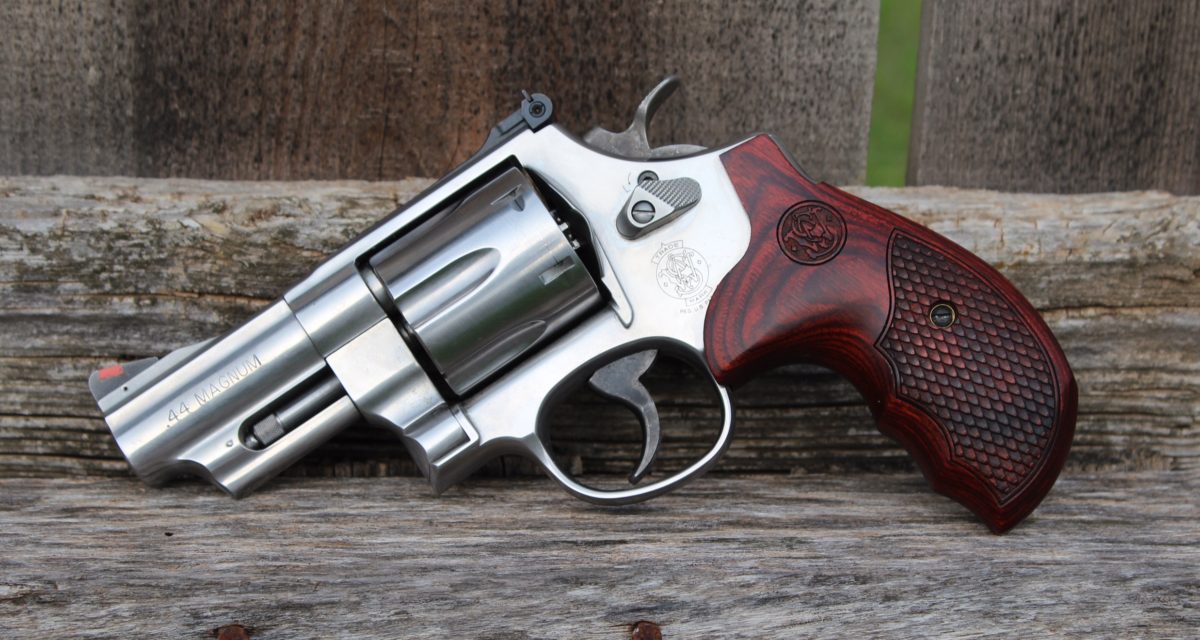
Mike,
You totally missed the Jovino & Behlert subset. They are full custom, serious self defense tools, and YES, they are snubs 🙂
Don’t believe me? Go ask Darryl B.
Haha! Maybe to you guys, but I lump ‘em in with the Compact Service Guns. My pockets don’t fit ‘em, and even with bell bottoms and a cane, I couldn’t ankle carry one! ; ^ )
Very large fan of 3”.44 Bulldog! Non LEO person!
Farmed Pecans in the Texas Brazos River bottom!!
Considerations:
Carried fairly large quantities of cash when harvesting.
Large feral hog population.
Large Alligator population.
Amazing Cotton Mouth Moccasin population.
Highest concentration of Rabid Skunks in the entire US.
State law at the time forbid private citizens from carrying handguns off of their own property.
Pre cell phone.
Carried BD in a custom holster in right western work boot for >10 years! Carried 3 hollow points & 2 CCI shot loads!! CCI also good to chase stray cows back home!!
.44 BD is the ultimate utility Snubby!! Everything else is a poor second!!
PS, loaded with target wadcutters it is a super Alligator gun!!
And last, if it has target sights it ain’t a snubby!!
Welcome aboard, Sir! I have to admit, I’ve never had to worry about alligator defense—-that would put a new spin on things! Enjoy that great Bullldog, um . . . snub? 😉
Mike,
This pretty well captures how I tend to think of the gun addressed. There a few I still have a hard time with:
-5-shot 38/357 revolvers with 3-inch barrels. I don’t think of a 3″ J-Frame or SP-101 as a snubby, and I just don’t think of anything under 6 shots as a service gun. I was still a kid when most officers were trading in their revolvers, so maybe that is a Hollywood-based opinion, but 5 shots and “Service” don’t go together for me. Maybe these are kit guns like the 3″ .22 J-Frames? I know some people will classify them that way and some won’t (which seems to revolve mostly around whether or not they have adjustable sights).
– 5-shot 38/357 revolvers with 4-ish-inch barrels. I think only the 4″ SP-101 and a couple Charter Target models fit in this category, but they are clearly not snubbies, and I don’t think they are service guns either (see above). In my mind, these are “backpack” guns, which would, I guess, be subset of the Outdoorsman’s Guns? The favour small size (but not really concealability) and shootability without the emphasis on ballistic performance that the other Outdoorsman’s Guns have.
Now, Greyson, there you go putting dents in my shiny new snubby system! ; ^ )
I admit those aren’t a neat fit. I’m not too concerned about the 3” J-Frame because I’ve known several folks who carried them in pockets or on ankles with no additional drama. The balance looks “wrong,” but I can’t argue with success—the longer snout doesn’t seem to compromise the concealable essence of a snub.
The 5-Shot .44s are more of an issue for me. Like you, I automatically think “6” when I think Service Gun, so the Bulldogs and such stretch the bounds of what I think of as a Service Gun. However, they also stretch the bounds of what I think of as a Snub, so in evaluating the “tie,” the heavier chambering tips the scales in my mind.
It wouldn’t be my first choice, but if you told me to go on duty with one of Ruger’s 3” GP100s chambered in .44 Special, I wouldn’t be concerned. I definitely wouldn’t think I was carrying a snub! The minute that chunk of steel, with the gaping .44 caliber holes in it, was in my hands and on target, there would be little doubt in my mind that I was holding a Service Gun.
I thought about the 3” Kit Guns and decided I was OK with thinking of them as snubs. A 4” Kit would definitely not be, however. Same with the 5-shot, 4” guns like the SP101 Match Champion—-I dismiss them as beyond consideration. A different class, entirely, I think. Obviously revolvers of some sort, but not snubs at all.
Should we consider an Outdoorsman Major and Outdoorsman Minor subsystem?
How many angels can dance on the crown of a snubby? ; ^ )
Nah, I think we should be content with the system as is. If you don’t deliberately leave some vagueness in the system, manufacturers (who definitely listen to us, right?) will only make things that fit in the defined system and we won’t get any of the wobblers anymore. That would be a sad way to use our massive influence on the gun companies.
Haha! Yes, I think you’re right, Greyson. Well played.
So interestingly, I just purchased what I consider to be a pretty well balanced gun, a S&W Model 60 with 3″ barrel. Solid steel and 3″ barrel make for recoil control, bigger velocity numbers, and easier aiming, but the small frame and round butt make it easy to carry. 357 magnum chambering qualifies it for any of the service pistol categories if it wants to be there.
Despite all that, I think it’s half a snub. Ultimately, I think barrel length is the main determining factor, and I personally draw the line not at some absolute barrel length number, but at some arbitrary value of the proportion of size between the frame and the barrel.
I had a 4″ K-frame for a while and that fell solidly into the service revolver category even though from an aesthetic perspective I would have much preferred a longer barrel – it was a bit on the snubby side for my taste.
Thanks for the thought provoking article!
You bet, Adam! It’s kind of a fun, but meaningless exercise. Just as we all share different preferences in guns, our ideas of what constitutes a snub will all be different.
A few years back, S&W sold some J-Frames with 2.5” barrels, and I thought the combination was neat. They had slightly longer ejector rods, but still had the right proportions-—while a 3” J-Frame looks decidedly nose-heavy, to me, the 2.5” barrels looked good, to my eye.
I bet your 3” Model 60 handles great! Do you find the extra inch of barrel makes any difference in how you carry it? I had a friend who carried a 3” J in a pocket, and the extra inch was no issue in the types of pants he preferred.
Mike,
For some reason the size of the pockets on my pants seems to vary drastically even within the same styles – some of my jeans have huge pockets that could easily swallow a 4″ K-frame, and some there is no way to pocket-carry even something like 1-7/8″ J-frame. That being the case, pocket-carry had to be relegated to something like a Kel-Tec P3AT or Sig P238, and I have traded in almost all my semi-autos in favor of revolvers this year.
I have a AIWB kydex, 4 o’clock OWB leather, and a leather shoulder rig that accommodates my Model 60, and it seems to disappear with each of them. The AIWB option always surprises me, I can wear a pretty tight T-shirt and you can’t tell that it’s there. I guess to answer your question, no – I never have to think about the barrel length. In all my years of carrying, the size of the grip was always the thing that determined how concealable a gun was, never the barrel… must be something about the way my body is put together. That being the case, and knowing that pocket-carry would never be an option for me outside the micro-semis, it didn’t make sense to me to accept the compromises that come with a shorter barrel if I could get something in the middle.
I think you made a great choice Adam, and I agree about the utility of AIWB carry. We’ve actually got an article on AIWB carry in the queue, so standby for that.
I can make my 2” 640 work in most of my pants pockets, but a 3” would be too long for some of them.
Barrel length is definitely more of a limitation on the ankle or in a pocket, but (within reason) ceases to be an issue on the belt. You’re right—the grip frame is what limits concealment on the belt, which is why the Compact Service Guns don’t offer a significant advantage over their brothers with the longer snouts. In fact, I’ve found a 4” K-Frame can conceal better than a 2.5”, because the longer barrel levers against the body and keeps the gun from tipping outboard, and printing—-especially in a holster that rides high.
Adam,
My Dad owns a 3″ model 60 and it is a dream to shoot. Especially .357 110 grain.
How would you categorize the 2” Smith and Wesson model 12-3?
K-frame; but relatively compact in size, relatively lightweight (18 oz.) due to its aluminum frame.
Well-suited to pocket carry, especially after I dremeled off the hammer.
I’ve been thinking of it as a snubby….
I meant to say, dremeled off the hammer spur….
Haha! When you wrote, “dremeled off the hammer,” I thought you were just making a Kalifornia-legal version! ; ^ )
The 12 is another wobbler, but I’d have to rate it as a compact service gun in my admittedly subjective system. Once again, the base gun is a service gun (a 4” aluminum framed Model 10, essentially) and we have shortened the barrel (and possibly round-butted it, depending on model) to make it more concealable. Yet, concealment is not the overriding priority here. Instead, preserving the capacity and handling qualities (the full length frame) of the service gun are the priority, and the modifications just enhance its concealability. If concealability was the primary concern, we’d go to a smaller frame, and take the hit in capacity and grip size.
That’s just how I see it. If you think your 12 is a snubby, then it is!
Incidentally, I’m envious that you have one of these! I’d love to own one, and would also like to see S&W bring one back (sans lock, of course). An aluminum frame K would be a super neat carry gun! It’s still too big for one of my pockets (we must buy pants in different places!), but would be dandy on the belt.
Always great to hear from you, LB!
Thanks, Mike! Always good to click on Revolver Guy, I rarely come away without learning something. And I’m glad you brought the comments section back.
However: I think we’d better keep your idea of a hammerless Kalifornia-legal revolver hush-hush…. here’s why:
What if Diane Feinstein and her buddies were to get wind of it, and extend that idea to all firearms? Think how much that would simplify things for them…
Rather than having to go to all the trouble of banning individual ‘assault weapons’, and high capacity magazines, and wasting all that ink and paper specifying precisely what those are: she and her gun-hating cronies could keep existing gun rights exactly as they are now— but simply make ownership of firing pins and hammers illegal!
Problem solved! And the Second Amendment doesn’t say anything about firing pins or hammers…
They could let us keep our guns and hi-cap mags, and buy all the ammo we wanted— heck, they could even rescind the restrictions on SBRs and silencers and full-auto weapons—just make it life in prison with no parole for anyone caught with a firing pin in their gun, or a hammer on their revolver.
I just hope Diane or Chuck or Beto aren’t reading this….
But on a serious note: when I think of pocket snubbies, I’m thinking about coat pockets. Even true snubbies— the 2” J-frames or Ruger LCRs— are too ‘bulgy’ to conceal in any pants pockets of mine, except cargo pockets: it’s obvious what’s in my pocket. My Sig P365 in a ‘wallet holster’ is my pants-pocket pistol.
It’s coat pockets where my 2” model 12 and 2” LCR .38 live….
It was from one of Greg Ellifritz’s excellent Active Response Training ‘Weekend Knowledge Dump’ Friday emails that I heard about the 2” model 12. I set a ‘saved search’ for it on Gunbroker, and was fortunate enough to snag one for a reasonable price (less than $350). Some cosmetic blemishes on the finish, I suspect that’s what kept the price down; but in fine shape otherwise.
And it was your excellent articles on the LCR here on RevoverGuy that inspired my purchase of that sweet little snubby. Now I’m keeping my eye out for the 6-shot 2” version in .327 Federal. They seem to be scarce…
So thanks! And please, keep up the good work! And stay safe….
LB
Thanks LB! It seems like these blogs are costing you money, but bringing lots of fun. ; ^ )
A Model 12 would be the perfect fit for a coat pocket. Enjoy that snub!
Yes, I do wish Scandium K frames were a thing.
I’d go with snub nosed is not a category exclusive or excluding, more based on appearance than function. I don’t look at a three inch j as a snub, but a three inch GP 100 is. It’s about proportions in my mind. Of course, I have a snub nose myself (one of my regular customers calls me “Officer Flat Nose”) but it functions the same as any other nose. Perhaps this is a case where size doesn’t matter?
“Officer flat nose,” huh? No wonder he’s a regular! ; ^ )
She’s not being hateful, just troubled.
Ah, yes, there’s a lot of that out there. Be safe, buddy.
Interesting as a old peace officer, I have carried a lot of snub guns. I think any thing bigger than a J frame Smith or D frame colt is not in the running . MTC
Mike,
This is a great article. We have similar thoughts on “what is a snub”. Its a frequent soap box of mine. I have been carrying a gun for 30+ years as a police officer. Most of the carrying has been concealed, both off duty and as a detective. I think the determining factor in a snub is overall size. I also think that fitting in a pocket is a good determiner of size. I’m almost never without my 2” J frame. A 3” barrel won’t fit in my pocket; however, my 6’5” academy classmate carried a 3” J frame, sometimes in his pocket, for 25 years. So, call what ever you want to a snub, I won’t be mad at you. I may make fun of you, but we’ll still be friends.
Thanks BC! Yes, I like the pocket/ankle criteria, because it really helps to separate the wheat from the chaff. If you think your N-Frame with a stubby barrel is a “snub,” then try hoofing it around in an ankle rig for a week and let me know if you’ve changed your mind! ; ^ )
Great to have you here. Be safe out there, friend.
It seemed as though I owned a couple snubbies but it turns out they’re “wobblers.” The new classification, which sounds rather benign and perhaps even comical, someday could be a legal defense boon: “Yes, Your Honor, it’s true I was carrying a concealed wobbler.”
Haha! I like how you think, Spencer!
Interesting article, but I contend that frame material/weight should join your criteria. I tend to carry my steel j-frame 649 (22oz) on my belt mostly, rather than in a pocket. The aluminum k-framed model 12 is 4oz lighter in its 2 inch version, and certainly as easy to carry in an ankle holster, if not in pants pocket.
Fair enough, Scott. I’ve never minded the weight of my steel 640 in a pocket or on the ankle, but think I’d have difficulty clearing a pant leg off the larger grip frame of a Model 12 in an ankle rig . . . at least with the pants I wear. Having said that, I have no problem with anyone who views a Model 12 as a snub, or adds another layer of consideration by considering weight! We all get to make our own rules on this one, which is part of the fun.
Mike,
Here in Brazil, many private security firms uses J-Frame, .38 Special, 5 shots, 4 inch revolvers, like Taurus 85 – 4 inch barrel and Rossi model 33 and 31.
It’s, at a first view, an odd combination, but are very adequate for women’s smaller hands. These guns are less bulky for belt carry, with no accuraccy loss typical of the shorter barrels.
I don’t think the 4″ J-Frames could be classified as snubbies, but a “thin service-sized” for smaller hands or better concealment on belt carry.
Very interesting, Erick! That’s not a common combination here. Ruger recently introduced their 4” SP101 Match Target, but I can’t think of any other 5-shot, 4” guns on the market right now. Maybe Charter has one? It sounds like it would be a good fit for some smaller-statured shooters.
According to my database of double action revolvers (which is based on the US market and very close to complete, but may be missing a few things), there are three 4″ 5-shot 38/357 guns: the Ruger SP101 (model 5771), the Ruger SP101 Match Champion (model 5782), and the Charter Arms Mag Pug Target (model 73542). If you go with 4″ barrels and the same frame size, then you can also add the SP101 in .327 Federal (model 5773) and .22 Long Rifle (model 5764), the Charter Arms Pathfinder Target (models 72242 and 72342 depending on whether you want .22 Long Rifle or .22 Magnum), and the Taurus 992 in .22 Long Rifle (which is discontinued). Given that I have 438 entries in my database, even the more generous list comes to a total of 9 guns (counting the blued and stainless versions of the 992 as separate guns) for 2% of the total. It is a size that I kind of like, but I have to agree that it is “not a common combination here.”
And S&W made a 5-inch Model 60 (nobody seems to know why) for a year or so back in the 90s. Try to find a holster for that!
Old 1911,
I had the same problem with holsters. I found an old stock of .32-caliber holsters, that fitted perfectly.
Any J-Frame with 3″ or longer barrel must be considered a .32 for holster search.
Groo here
You forgot the “fighting revolver”……
Large frame , big bore, 3 to 5 inch barrel, and fixed sights.
Usually NOT a magnum but could be…
AND the hunting revolver , 5 inch barrel [or longer] good sights , heaver frame, 357 mag min.
You show a M-327 pc “pug” that is an 8 shot 357mag N-frame,,, BUT with a 2 in barrel,
round butt, fixed sights AND at 23oz few would not call it a “snub”
The discussion is interesting ,, I would submit ,a Snub is a barrel length, a CCW is a overall size/weight.
A service is a general purpose 3ish [ 2 3/4into five in], a sportsman is to stop whatever [fighting]
And a hunter is BIG and HEAVY………
I didn’t forget them Groo, I just didn’t consider them for the snub discussion because they’re clearly in a different class. I love those big guns too, but nobody is at risk of calling a 5” gun a snub! Maybe we should do another article to classify all the non-snubs?
The question of ‘what is a snubby’ is akin to asking how many angels can dance on the head of a pin, and, what is your definition of an angel and what size is the pin.
Generically speaking, I would suspect that when most folks think of a snub gun, they’re envisioning something, anything, with a two inch barrel and they stop at that.
A 2″ Model 10 S&W is a ‘snub’ gun, but is it a viable ‘snub’ gun ? Those who are very attentive to their rotational magazine feeders don’t stop with barrel length but also factor in overall size, weight, and ease of carry and concealment. Eggsample: A 2.25″ barrel Ruger SP-101 might be considered a snub gun, but at 25 ounces, is it something that is practical to drop in your pocket for a run to the local Stop-n-Rob ?
When I started on the job back in 1972, the perception of carry sidearms was something of a three tier structure. Your issued 5″ barrel N-Frame .357 Magnum was your full size duty gun that doubled as an emergency tire chock for an 18 wheeler. The next group took in revolvers like the 2.5″ M19/66 Combat Magnum, 2″ S&W M15, 2.75″ Ruger Security-Six, 2.5″ Python and 2″ Colt Mk III; all of which were just short versions of duty guns that carried easier in a belt holster off duty, and weighed a tad less than the on-duty holstered anvil, and appeared to balance better. (notice a trend?)
The third group were the snub guns – and there were two that were considered to be in that group – both with 2″ barrels: (a) Smith & Wesson’s J frame .38 Special and (b) the Colt’s Defective Special (or Cobra, or Agent) .38 Special. You would find yourself checking to make sure you didn’t leave it somewhere because, compared to your duty gun, they weighed next to nothing. That was it, and no one argued any different.
Fast forward to present time when you have S&W J frames made of Unobtainium Nitride weighing 11 ounces (definitely snub class), and chambered for .357 Magnum (definitely something else). In an urban sewer (Atlanta proper) the light weight J-frame like the 642, 37, and other flyweights might be just the ticket. For someone living in rural Wyoming, maybe not so much. In rural wilderness, I would consider that 2.5″ Ruger Redhawk in .44 Magnum, or .454 Casull a ‘snub’ gun that is far more easily packed than something larger.
Middle of the road – well, probably the 3″ barrel K frame .38/.357 round butt. That is in a niche all of its own.
The important question . . . would the 5” N-Frame work to chock a loaded trailer, or just an unloaded one? ; ^ )
How many angels can dance on the crown of a snub?
Generally, on level ground, only one N-Frame is needed. On inclines, ideally you’d want a backup unit on scene and use his N-frame as a safety chock, especially on a loaded rig. If it gets dicey, you just place your unit’s rear bumper against the front bumper of the rig, directly opposite of the direction the rig will roll if it lets go.
Angels on a snub crown – well it depends. If the angels are petite little size 2 types, on the J-frame, I think it was eight, and on the Colt D-frame, there was marginally room for nine. If they were BBA (Big Beautiful Angels), it was two (J-frame) or 3 (D-frame) each. If they were really ‘large’ – one could sit on both.
Hahaha! “Dispatch, advise S1 we’re gonna need another N-Frame.” ; ^ )
I know my 642 and 856UL 2″ qualify and my SP101 .357 4.2″ doesn’t.
What about my LCRx .22 WMR 3″? It fits in my pocket, but that hammer spur!
Wouldn’t carry it on my ankle.
Nah, don’t think so.
SG2 is fantastic! Clean, no-nonsense site.
Very nice breakdown. While the steel j-frame and scandium 327 have similar weights, the bulk makes a world of difference, which you don’t always get from pictures.
The 3″ j-frame puzzles and intrigues me. Not sure of the ideal use case for it, but it’s got a nice look, it’s got the lighter weight of a j-frame. Would be svelte and out of the way, and yet have a respectable sight radius and velocity.
As an extreme example of what the hell is that, 30 years ago a friend cut off a Colt Walker replica where the barrel becomes round and took off the loading lever. He then installed a front sight. We (his friends) called it his “Walker pocket model”. Snubby? I don’t know. It sure looked intimidating
That boy must have HUGE pockets!
Per thefreedictionary.com the definition of snub is: “unusually short” hence it would seem to me that anything 3” or less would qualify. Yes, that is a totally subjective opinion. And, that way my 3” GP100 qualifies, all 40+ ounces of it!
Matt,
Putting the weight, and even the size, aside, you have probably THE most rugged, reliable, and effective ‘compact service’ revolvers currently on the market. I have had one since @ 1990 – and it’s seen a LOT of miles and a lot of magnum rounds sent through it.
Greyson,
In this odd category we have only the Taurus 85 in current production.
Rossi made the Model 31 (fixed sights), 38 “Champion I” (adjustable sights) and 881 (stainless, fixed sights).
The 31 model is mentioned in three different catalogs, from 70’s, 80’s and 90’s. It was the cheaper .38 Special revolver at that time in our country. Due its lower price, most are sold in great numbers to private security firms.
Model 881 Stainless is only mentioned in 80’s catalog, and Model 38 Champion I only in 70’s.
My primary EDC is a 3″ model 13. It fits in the compact service gun category but that doesn’t really seem like the best description. I find that it carries much better than the 4″ duty revolver, the shoot ability is very comparable to the full size duty gun. I find that the gun conceals incredibly well but not quite as good for deep concealment as the 2″ J frame.
For me it is the perfect concealed carry fighting revolver. It is my preferred gun for all around use. For others maybe not.
Sounds EXACTLY like a Compact Service Gun to me, Randy! The handling qualities, power and capacity of a Service Gun, but it carries better and is more concealable . . . but not as concealable as the smaller guns. The textbook definition, according to my subjective system!
Enjoy that great gun!
Quite a thought-provoking article, so I think I’ll provoke some thoughts with my provoked thoughts.
I tend to agree that anything bigger than a J-frame or a D-frame is not a true snub. However: I think that one of the things that differentiate a true “snub” from a “short-barreled revolver” is the sights. True “snubs” have fixed (usually gutter) sights that let the revolver be carried in a pocket holster or on an ankle without snagging on the draw or being knocked out of alignment, either on the draw or by banging the gun against things. For instance, a 2-inch Detective Special is a snub, but a 2.5-inch Diamondback, which is just a prettied-up DS, is a short-barreled revolver. I’d go so far to say that in some uses, a 2-inch Model 10 is a snub, but a 2-inch Model 15 isn’t. Back in the day, S&W made 2-inch Chief Specials with adjustable sights; I would say these were “short-barreled revolvers” and not snubs, because of the sight-snagging problem on drawing from a pocket or an ankle.
An excellent point to consider! I like that very much.
Smith and Wesson Terrier 38 S&W, an I-frame should be included.
Ed, it definitely fits the snub profile. My system wouldn’t exclude it.
Well Golly ( in a Goner Pyle voice) I thought a snubnose was a cut down service revolver. Aka the Shopkeeper single actions. And how bout the J Chief’s Special when it was introduced- wasnt it intended to be used as a service revolver by Police chiefs and other admin types? How bout the stainless J Chiefs Special- I remember how rare and a premium paid for it by G I.’s heading to S.E. Asia. Wouldn’t that make it a “service revoler”? Maybe not. How bout my 327 as pictured? Many of us that own one call it a Pug Nose- does that make us orphans and we dont get to play? Human nature I guess to categorize and classify everything. How about calling them “That Thar Gun I Gots To Stick In My Trousers So’s Nobodies Knows”? Too long eh? I know -let’s just call em Snubs.
C’mon, Mike. Everyone knows that “Chiefs and admin types” don’t do police work. ; ^ )
“Chiefs and admin types” don’t do police work. ; ^ )
Up until late 2020, I’d have said “I resemble that remark!” or at least represent it. ;-P
To address Mike-In-The-Truck, everyone is going to have their own determination on what is a ‘snub’ versus a short barrel service revolver. For a VERY short time, the USAF issued an all aluminum alloy 2″ K frame .38 to air crews. Even the anemic M41 ball appeared to be too much for them and they were recalled.
True, the first stainless Model 60s were allotted to Southeast Asia in the 1960s. They brought a premium price, but they weren’t used so much as service weapons as a SHTF backup. I saw several at a certain air base that didn’t exist where it wasn’t supposed to exist being carried by air crews.
My partner was able to acquire one and carried it constantly notwithstanding the other equipment available. The ammo for it, the M41 Ball, wasn’t spectacular out of a 2″ barrel, but a 130 grain FMJ beat a poke in the eye with a punji stick.
I came home with the S&W M36 that I was able to snag, and it rode a lot more miles under a light bar (usually loaded with 148 grain wadcutters)
I think the problem is that “snub gun” has been bastardized out of “snub nosed gun”. Online sources defines the latter as “any revolver that has a 3″ barrel or less” and old Webster says that ‘any revolver with a very short barrel”. The modern gun geek speak has given us “snub gun” which means a small revolver usually speaking directly about a J-frame or LCR and giving the SP101 a very slight nod. So a N-frame .44 Magnum with a 2 inch barrel is a snub nosed revolver.
I think you hit the nail on the head with the categories. I would have to classify my two shorty’s as compact service guns as the large grips I have on them take them out of the snubby category in my view. A 2 1/4″ SP101 and a 3″ King Cobra with Bill Jordon sized grips makes them a crossover…..ain’t nobody stuffin’ them in a pocket.
Nice write up!
Thanks Dave, glad you enjoyed it! It was a fun exercise.
Great snubby article, Mike!!
Hey, Justin… I imagine you’re tired of that S&W 640 Pro by now. You can just ship it to my house. 😉
WGJ
Now, why didn’t I think of that myself, Judy?
I thoroughly enjoy this place.
Good to hear from you again, Jack.
I think a K-Frame snub like the 2″ Model 10 or Model 12 are the upper limits of what I’d consider a snub, going by the definition in this article. I can carry my 2″ Model 12 in a (cargo) pants pocket comfortably while remaining concealed. Which is pretty nice, because a snub-nosed K-Frame is a lot more shootable than a J-Frame, in my personal experience.
Indeed, it can make a big difference when you step up to the K from the J.